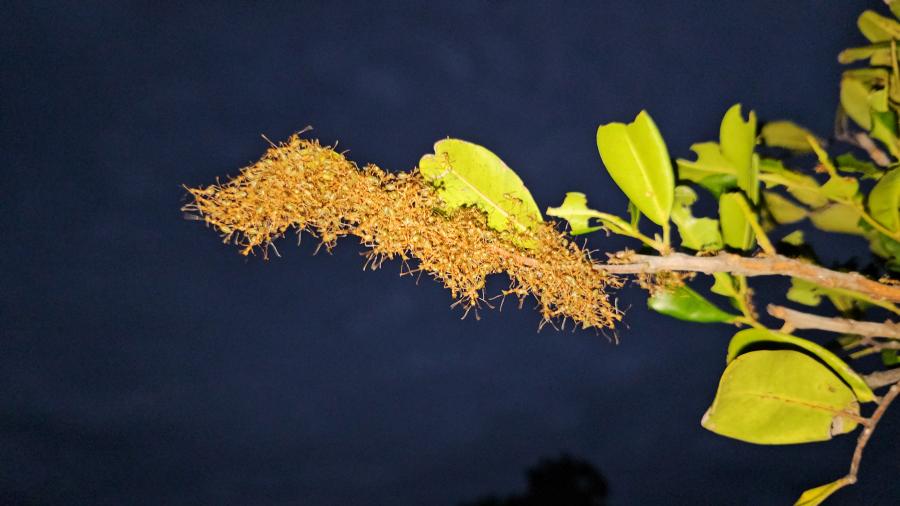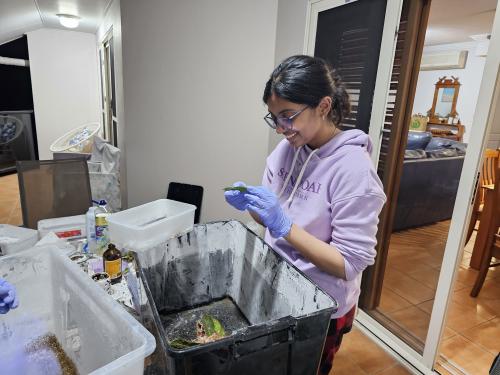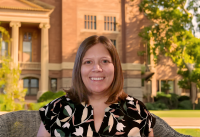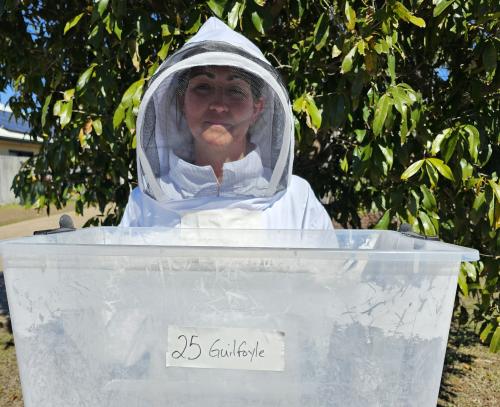SOLS students travel to Australia, bringing 39 ant colonies back to Tempe for research projects

In July, SOLS professors Ted Pavlic and Jessie Ebie brought two PhD students and one undergraduate student with them on a field work trip to Townsville, Queensland, Australia. While on the trip, they observed and collected weaver ants to bring back to their labs in Tempe.
The weaver ant colonies that were collected and brought back to their labs in Tempe will be used to further their research in cooperative behavior and communication & reproductive regulation within the colonies.
Cooperative behavior concepts can be used in engineering

Pavlic, whose research focuses on the cooperative behavior of ants, was particularly intrigued by how weaver ants manage to transport large objects in teams, despite the challenges posed by their spatially separated sub-nests. His work investigates the decision-making processes involved when ants from different subunits come together to move food items. This cooperative transport not only involves horizontal movement but also the vertical challenge of carrying objects up trees. Pavlic, who is jointly appointed in ASU’s School of Computing and Augmented Intelligence, does research that extends beyond biological curiosity, seeking to apply these natural mechanisms to engineering and robotics.
“The weaver ants’ ability to carry objects up trees and resolve decision points in decentralized ways offers insights into broader natural problem-solving mechanisms,” Pavlic explained. His work aims to understand how these trade-offs in nature can inform the design of more effective robotic systems.
Anoushka Dasgupta, a PhD student in Pavlic’s lab studying animal behavior and fascinated by cooperative transport, was captivated by the weaver ants’ ability to coordinate their efforts in both horizontal and vertical movements. Her research focuses on how these ants make decision-making regarding food transport and how they interact with it.

“An incredible amount of strength is required for these tiny ants to carry these things that are huge compared to them, like crickets and mealworms” Dasgupta noted. The trip allowed her to see firsthand the contrasts between the desert ants of Arizona and the Australian weaver ants, deepening her understanding of how these species manage cooperative transport under different environmental conditions.
“I was able to observe the ants in their natural setting, which was incredibly beneficial for understanding their behavior in the wild,” she explained. “It’s one thing to study them in the lab, but seeing them in action outdoors provided a whole new perspective.”
Decoding communication and reproductive regulation
Ebie's research centers on the communication and reproductive regulation within weaver ant colonies. These colonies, which can span up to a dozen trees, rely on complex chemical signals to coordinate their activities. Her work seeks to identify the compounds responsible for signaling the presence of the queen, who resides at a central location within this sprawling network of nests.

“Our goal is to pinpoint the exact chemical signals used by the queen to regulate worker reproduction,” Ebie says. This research not only enhances our understanding of ant behavior but also has practical applications, such as developing synthetic attractants to temporarily lure ants away from fruit trees during picking season and then back into the trees to ward off pests during growing season, benefiting local farmers.
Ariel Aslan, an undergraduate student double majoring in ecology and conservation biology and data science, was fascinated by the reproductive communication within weaver ant colonies. Her observations highlighted the unique ways ants build their nests using silk produced by their larvae and their aggressive territorial behaviors.
“I was amazed by how the ants use their larvae as natural glue guns to weave nests and how they defend their territory with such intensity,” Aslan remarks. Her experiences in the field, including the challenges of working closely with these ants, provided a deep appreciation for the complexities of their social structure.
Aslan found the process of collecting queen nests both exhilarating. “Seeing the ants react to the queen pod was like a treasure hunt. For me, seeing this gave me a rush of excitement because I knew I was about to find the queen. ”

Beth Ponn, a PhD candidate in the Animal Behavior program in the Ebie and Liebig labs, focuses on how the queen’s signal is transmitted across vast areas of the colony. Her research aims to identify the specific signals that communicate the queen’s presence and maintain colony cohesion.
“The concept of ants acting as a single organism is intriguing,” Ponn says. “Studying how they manage to coordinate and maintain their collective functioning over large distances offers insights into their social dynamics.”
Ponn’s research will also emphasize the importance of understanding how these signals are communicated and maintained across the colony.
An immersive experience

Reflecting on the trip, Pavlic emphasized the importance of fieldwork in education. “When a student goes out and is in the field and starts seeing the ants do things on their own that they didn’t make them do and start asking their own questions, you can see them get a new grounding in why it’s significant,” he says, and Ebie agrees, “It allows students to put those questions in context. They can see what you’ve been explaining and actually see and discover those nuances. It’s an opportunity to see the things we’re talking about in the classroom in real life and these interactions between different organisms. It’s invaluable in education.”
For Aslan, she says that working alongside other academics has shown her what that path can look like when she graduates. “I’m only a sophomore right now, but I think I would like to get my PhD. That’s been my idea for a long time because I want to develop my own questions, continue to learn and make contributions to the scientific field. As a student, this trip was a dream.”